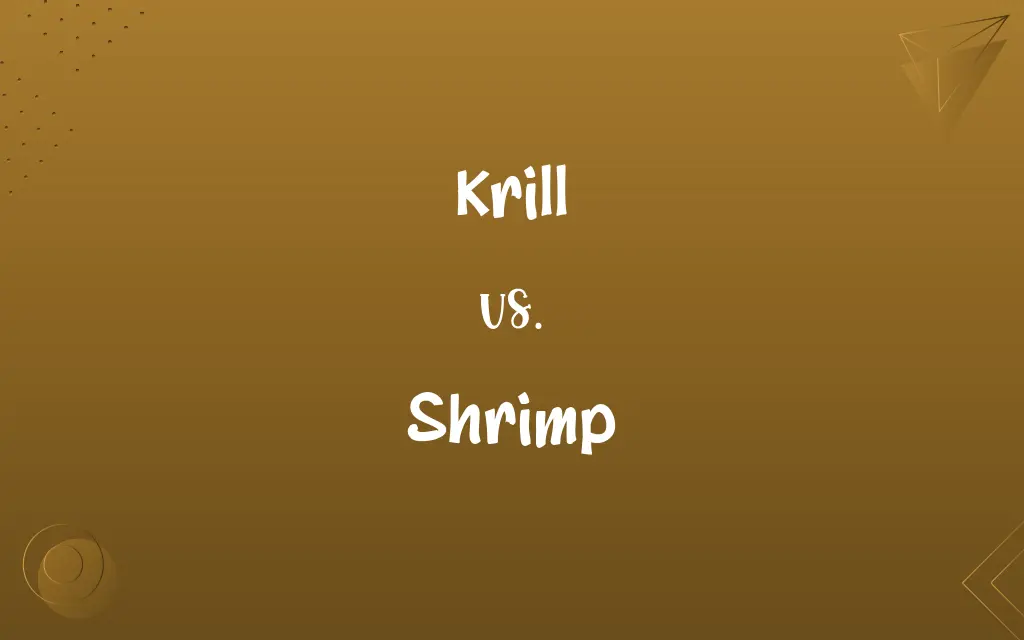Krill vs. Shrimp: Know the Difference

By Shumaila Saeed || Published on January 16, 2024
Krill are small, ocean-dwelling crustaceans in the family Euphausiidae, crucial in marine food chains; shrimp are larger, diverse crustaceans found in various aquatic environments, valued for consumption.

Key Differences
Krill are small, pelagic crustaceans belonging to the order Euphausiacea, predominantly found in cold ocean waters such as the Antarctic and North Atlantic. They play a crucial role in the marine ecosystem as a key food source for larger marine animals like whales and seals. On the other hand, shrimp are a diverse group of crustaceans found in both fresh and saltwater environments. They vary greatly in size and habitat, with some species thriving in the deep sea and others in coastal waters.
Shumaila Saeed
Jan 16, 2024
Krill are typically smaller than most shrimp, averaging about 2 inches in length. They have a semi-transparent exoskeleton and are known for their large swarms, which can turn areas of the ocean pink or red. Shrimp, in contrast, are more varied in size and color, with some species growing up to 12 inches long. They usually have a more robust and colorful exoskeleton compared to krill.
Shumaila Saeed
Jan 16, 2024
The diet of krill primarily consists of phytoplankton and small zooplankton, making them primary consumers in the ocean food web. They employ their fine, feather-like filtering apparatus to strain their microscopic food from the water. Shrimp have a more diverse diet, including detritus, algae, and smaller animals, depending on the species. They are known for their scavenging habits and also play a significant role in maintaining the health of their aquatic ecosystems.
Shumaila Saeed
Jan 16, 2024
Reproduction in krill involves large-scale synchronous spawning, resulting in the release of thousands of eggs into the water column. The larval stages of krill are complex and undergo several metamorphoses before reaching adulthood. In shrimp, reproductive strategies vary widely across species. Some carry their fertilized eggs on their abdomen until they hatch, while others release eggs into the water.
Shumaila Saeed
Jan 16, 2024
In terms of human interaction, krill are primarily harvested for their oil, which is rich in omega-3 fatty acids, and as feed for aquaculture. Shrimp, however, are a major food source globally, with a large fishing and aquaculture industry dedicated to various shrimp species.
Shumaila Saeed
Jan 16, 2024
ADVERTISEMENT
Comparison Chart
Role in Ecosystem
Primary consumers, feed on phytoplankton
Diverse roles, including scavengers
Shumaila Saeed
Jan 16, 2024
Reproduction
Large-scale spawning, complex larval stages
Varied, some carry eggs, others release
Shumaila Saeed
Jan 16, 2024
ADVERTISEMENT
Krill and Shrimp Definitions
Krill
Small, oceanic crustaceans of the family Euphausiidae.
The Antarctic ecosystem relies heavily on krill as a food source.
Shumaila Saeed
Jan 03, 2024
Shrimp
Crustaceans with a variety of colors and sizes.
The colorful mantis shrimp is known for its striking appearance.
Shumaila Saeed
Jan 03, 2024
Krill
A primary source of omega-3 fatty acids in marine diets.
Krill oil is extracted for its nutritional benefits.
Shumaila Saeed
Jan 03, 2024
Shrimp
Scavengers playing a key role in aquatic ecosystems.
Shrimp help keep the ocean floor clean by scavenging.
Shumaila Saeed
Jan 03, 2024
Krill
Tiny shrimp-like creatures inhabiting cold ocean waters.
Krill swarms can be so dense they color the ocean surface.
Shumaila Saeed
Jan 03, 2024
ADVERTISEMENT
Shrimp
Commercially valuable seafood, often farmed or wild-caught.
Shrimp farming is a significant industry in coastal areas.
Shumaila Saeed
Jan 03, 2024
Krill
Planktonic organisms crucial for marine food chains.
Whales consume millions of krill daily.
Shumaila Saeed
Jan 03, 2024
Shrimp
Any of various small, chiefly marine, often edible decapod crustaceans that have a laterally compressed, elongated body with long antennae and long legs used for swimming. The shrimps include species belonging to the superfamily Penaeoidea of the suborder Dendrobranchiata and to the infraorder Caridea of the suborder Pleocyemata.
Shumaila Saeed
Jan 02, 2024
Krill
Crustaceans known for their large swarming behavior.
Krill form vast swarms that are visible from space.
Shumaila Saeed
Jan 03, 2024
Krill
The collection of small marine crustaceans of the order Euphausiacea that are the principal food of baleen whales.
Shumaila Saeed
Jan 02, 2024
Krill
Any of several small marine crustacean species of plankton in the order Euphausiacea in the class Malacostraca.
Shumaila Saeed
Jan 02, 2024
Krill
Shrimp-like planktonic crustaceans; major source of food for e.g. baleen whales
Shumaila Saeed
Jan 02, 2024
Shrimp
Any of many swimming, often edible, crustaceans, chiefly of the infraorder Caridea or the suborder Dendrobranchiata, with slender legs, long whiskers and a long abdomen.
Shumaila Saeed
Jan 02, 2024
Shrimp
Synonym of butterface: a person with an attractive body but unattractive face.
Shumaila Saeed
Jan 02, 2024
Shrimp
Any one of numerous species of macruran Crustacea belonging to Crangon and various allied genera, having a slender body and long legs. Many of them are used as food. The larger kinds are called also prawns. See Illust. of Decapoda.
Shumaila Saeed
Jan 02, 2024
Shrimp
Figuratively, a little wrinkled man; a dwarf; - in contempt.
This weak and writhled shrimp.
Shumaila Saeed
Jan 02, 2024
Shrimp
Small slender-bodied chiefly marine decapod crustaceans with a long tail and single pair of pincers; many species are edible
Shumaila Saeed
Jan 02, 2024
Shrimp
Aquatic crustaceans with elongated bodies and long antennae.
Shrimp are a popular choice in seafood dishes.
Shumaila Saeed
Jan 03, 2024
Shrimp
Diverse species found in both fresh and saltwater.
Freshwater shrimp add diversity to home aquariums.
Shumaila Saeed
Jan 03, 2024
Repeatedly Asked Queries
Are krill used by humans?
Yes, krill are harvested for oil and aquaculture feed.
Shumaila Saeed
Jan 16, 2024
What are krill?
Krill are small crustaceans found in cold ocean waters, important in marine food chains.
Shumaila Saeed
Jan 16, 2024
Are shrimp important to humans?
Yes, shrimp are a major global food source and are widely farmed.
Shumaila Saeed
Jan 16, 2024
What is the average size of a shrimp?
Shrimp sizes vary, with some species reaching up to 12 inches.
Shumaila Saeed
Jan 16, 2024
What do shrimp eat?
Shrimp diets vary, including algae, detritus, and small animals.
Shumaila Saeed
Jan 16, 2024
Do krill form swarms?
Yes, krill are known for forming large swarms in the ocean.
Shumaila Saeed
Jan 16, 2024
Can krill be seen from space?
Yes, large krill swarms can sometimes be visible from space.
Shumaila Saeed
Jan 16, 2024
Do krill have any predators?
Yes, krill are preyed upon by whales, seals, and other marine animals.
Shumaila Saeed
Jan 16, 2024
Do shrimp live in fresh or saltwater?
Shrimp can be found in both fresh and saltwater environments.
Shumaila Saeed
Jan 16, 2024
How do krill reproduce?
Krill reproduce through large-scale spawning with complex larval stages.
Shumaila Saeed
Jan 16, 2024
How do shrimp reproduce?
Shrimp reproduction varies; some carry eggs while others release them into water.
Shumaila Saeed
Jan 16, 2024
Is shrimp farming common?
Yes, shrimp farming is a significant industry in many coastal regions.
Shumaila Saeed
Jan 16, 2024
What are shrimp?
Shrimp are diverse crustaceans found in various aquatic environments.
Shumaila Saeed
Jan 16, 2024
Are all shrimp edible?
While many species are edible, not all shrimp species are consumed by humans.
Shumaila Saeed
Jan 16, 2024
Do krill live in warm waters?
No, krill predominantly inhabit cold ocean waters.
Shumaila Saeed
Jan 16, 2024
Share this page
Link for your blog / website
HTML
Link to share via messenger
About Author
Written by
Shumaila SaeedShumaila Saeed, an expert content creator with 6 years of experience, specializes in distilling complex topics into easily digestible comparisons, shining a light on the nuances that both inform and educate readers with clarity and accuracy.









































































